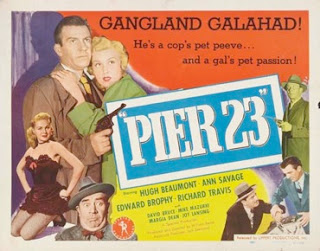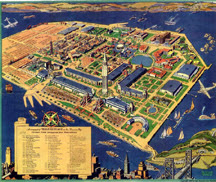Oddball Films Media
•
Sep 1, 2016
Trip Down Market Street
Be-In
Trips Festival
Innocent Fair 1962
Blackie the Wonder Horse
Groping Hand
Hell on Frisco Bay
Deconstruction of Playland Kodachrome 1972
Rails and re-bar and construction bulldozers disassembling the massive construction of Playland-at-the-Beach in San Francisco. Observers mill about watching the scene.
Streets of San Francisco: One Last Trick 1977
The show revolved around two police officers who investigated homicides in San Francisco. The centre of the series was a veteran cop and widower, Lt Mike Stone (Karl Malden), who had more than twenty years of police experience and was now assigned to the Homicide Detail of SFPD's Bureau of Inspectors (ex: Detective Division). He was partnered with a young, plainclothes detective and energetic partner, Assistant Inspector Steve Keller (Michael Douglas), a college graduate, age twenty-eight, who had no experience in the police force.
In this episode, a former prostitute goes back to work to smoke out the murderer of another prostitute.
Streets of SF: Asylum
The show revolved around two police officers who investigated homicides in San Francisco. The centre of the series was a veteran cop and widower, Lt Mike Stone (Karl Malden), who had more than twenty years of police experience and was now assigned to the Homicide Detail of SFPD's Bureau of Inspectors (ex: Detective Division). He was partnered with a young, plainclothes detective and energetic partner, Assistant Inspector Steve Keller (Michael Douglas), a college graduate, age twenty-eight, who had no experience in the police force.
In this episode, Keller goes undercover at a mental hospital to uncover the truth about a string of mysterious deaths.
El Tecolote: A History of a Raza Newspaper 1970s
A look at the production of El Tecolote, a newspaper published in San Francisco’s Mission district. Shows old "web" press, newspapers tied in stacks, newspaper delivery. Pasteup of boards, including drawing and setting before production. Traveling shots of the Mission district, Tower theater. 1960s/1970s(?).
Image

The first half of a two-part film titled Pier 23, this tasty little San Francisco pocket-noir has all the right ingredients: the rigged boxing match, the alcoholic professor, the slitheringly sexy femme fatale, the meat-headed/ham-fisted henchman, and, of course, the quick-talking, morally ambiguous, Marlowe-like amateur detective, who finds himself smack in the middle of a frame. Hugh Beaumont plays our snappy detective, who would go on, only a few years later, to play the far more wholesome father, Ward Cleaver, in TV’s Leave it to Beaver. Here, however, you’ll get to see him wheelin’-and-dealin’ in the seedy underbelly of our own San Francisco.
San Francisco’s Ageless Cable Cars (1955, color)
Traverse the classic haunts of San Fran through the eyes of the cable car. Andrew Hallide brought the cable car system to America after witnessing a terrible accident of horses and a carriage trying to make their way down a steep SF hill in the late 1800’s. Today, it is still the most appropriate form of transportation over and about San Francisco’s steep hills and valleys. This doc takes the viewer through the routes of the cars and illuminates its many characters and uses along the way.
Hell On Frisco Bay (1955, color - excerpt)
No show about San Francisco is complete without a noir featuring the famed Edward G. Robinson, Alan Ladd and Joannne Dru. A man seeks vengeance after being falsely imprisoned set-up by an unknown enemy. Set in the city by the bay and featuring every motif known to noir, the opening of this film is sure to revive your sense of intrigue that defines what it is to be literally so close to your dreams yet still fathoms away.
Short Various (1930’3-1980’s) color/bw
This collection of footage, short films and newsreels covers SF from a slicked up and glittering town to the nitty gritty of the people who fill it. Includes the first TV broadcast in San Francisco, footage from the 1906 quake aftermath, hippies and low-riders. Also includes wild silent outtakes of Harvey Milk, Dan White, and other SF crime oddities.
1939 Golden Gate International Exposition (Color, 1939, Silent)
Absolutely stunning color scenes from the World’s Fair held on Treasure Island. The Golden Gate International Exposition celebrated the modern industrial west, best symbolized by the completion of two engineering marvels—the Golden Gate and the San Francisco-Oakland Bay Bridges. The fair was staged on another feat of modern engineering, the manmade Treasure Island in San Francisco Bay. The exposition’s “Pacifica” modern style, developed largely by San Francisco architects, merged western architecture with an interpretation of the buildings of Asia and South America.
Highlights most of the major sights, including the incredible Cavalcade of the Golden West with casts of 300, horses, wagons, and costumed actors re-enacting historic events, Count Basie and Harry Owens performing in the Temple Compound, and the famed “Gay Way” featuring an uncensored look inside the “Artists Models Studio” and much more- the next best thing to being there!
Trojan Horse (Prod. Ronald Bostwick/Robert Blasdell, Color, 1967)
Documents the creation of the amazing rolling sculpture designed by outsider artist Fredric Hobbs, unleashed on San Francisco during the Summer of Love. Clad in an orange jump suit, Hobbs drives his creation all over our beautiful city from Haight Ashbury to North Beach, Lincoln Park to downtown, culminating in a final, ignominious act: the issuance of a parking ticket by one of San Francisco’s finest.
Arriving in San Francisco in the late 1950’s after studying in Madrid, artist Fredric Hobbs Goya-inspired paintings “were populated with demons performing sacrifices and contemporary witches’ Sabbaths… his grotesque figures gradually became translated into sculpture. In the early 1960’s- inspired by the folk idols used in pagan rituals and primitive religious processions- Hobbs began adding wheels to his mutilated Everyman and deformed Earth Mothers and rolling them about the streets. His most ambitious “parade sculpture” was The Trojan Horse, a horrendous tableau of mythological monsters that rose from Procrustean slags of plexiglass attached to a stripped-down auto chassis. Wearing an orange jump suit, Hobbs drove the creation to Los Angeles, where it exhibited at several locations”. (Thomas Albright- Art in the San Francisco Bay Area, 1945-1980).
Hobbs went on to make several insanely bizarre, Bay Area-based cult films in the early 1970’s, including Roseland, Alabama’s Ghost, and Godmonster of Indian Flats.
A Trip Down Market Street (B&W, 1906)
A Trip Down Market Street is a different kind of road trip movie than the others screened in this program. Filmed in 1906 from the front of a cable car, the film travels from 8thstreet to the Embarcadero, during which time we are able to get a glimpse of the frenetic and bustling city life of San Francisco at the turn of the century. Originally thought to be filmed in 1905, historians have recently discovered that the film was actually shot just days before the earthquake that destroyed much of what we see documented. This short is a valuable document for the history of the Bay Area, and a true gem.
San Francisco: Queen of the West (Color, 1947)
Lost San Francisco in stunning color- this post-war travelogue covers all the sights our fair city is famous for; some is remarkably the same, others lost to history. Notable shots include Chinatown’s own telephone exchange and the colossal neon nightlife Babylon.
Banana Skin Freaks (1960s) Hippies in Golden Gate Park freak-out with banana skins (Remember the Donovan song “Mellow Yellow”?) you know the fruit skins that supposedly made you high...what else?
“Parole” (1965, B+W) Reality based TV series shot on location inside San Quentin Prison.
“36” Baton” (1970, B+W) Watch the SF Police Dept demo as they pummel a dummy perp!
“The Use of Mace” (1968, Color) Tested live on a real human volunteer-it burns!
“Beat Patrol and Observation” (Color, 1965) Shot on location in idyllic(!) Richmond, Ca.
“Physical Evidence Gathering and Analysis” (Color, 1972) Crime scene methods.
“Inmate Body Searches” (Color, 1980) Checking for contraband.
“San Francisco Bombing” (Color, 1970) Notorious SF Police Dept Park Station bombing.



